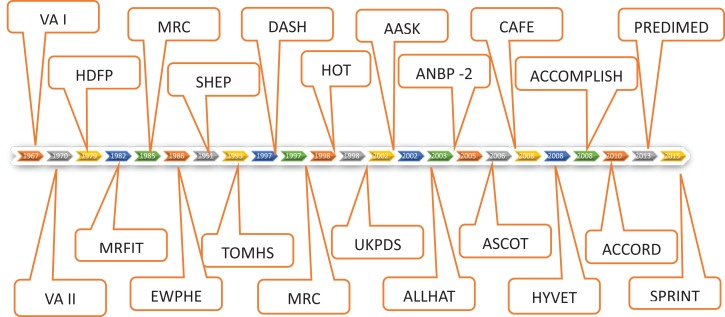Figure 1.
VA-co-op study phase 1 followed by 2 established for the first time that diastolic HTN > 90 to 129 was treatable with available drugs and reduced stroke, CHF, and mortality. HDFP study affirmed that BP treatment target to diastolic goal of 90 gave much better CV outcome results than usual BP treatment. MRC and EWHPE confirmed this for younger and older patients, respectively, in non-US population. MRFIT study showed that of three risk factors for CHD (hyperlipidemia, smoking, and hypertension) only hypertension was effectively treatable by drugs available that time. SHEP study broadened the definition of treatable hypertension to include isolated systolic hypertension, treatment of which in elderly gave profound CV and mortality benefits. DASH study convincingly showed the benefits of Mediterranean type diet in lowering BP and that salt restriction adds to that benefit. HOT study established that lowering diastolic BP goal <90 (85 or 80) does not add any further benefits. TOMHS and MRC 2 were relatively minor studies. UKPDS Hypertension studies showed that moderately tight BP control <150/85 goal-reduced diabetic mortality by 32% – much higher level of benefits than in non-diabetics. AASK study was done in African-Americans with CKD and showed that tight BP control over usual BP control did not affect CKD progression but use of ACEI caused superior reno-protection over CCB. ALLHAT study showed that use of thiazide drugs (Chlorthalidone) did not increase incidence of MI or mortality over other classes of drugs (CCB, ACEI, or AB). It also showed incidence of CHF was more with use of AB, CCB, and ACEI than CTDN. ASCOT study showed superiority of combination of ACEI and CCB over BB and thiazide (HCTZ) in preventing CV outcomes. CAFE, a sub study of ASCOT showed that BB failed to lower central aortic BP as opposed to peripheral BP. HYVET showed that treatment of hypertension in very elderly (>80) is even more beneficial than in any other age group. ACCOMPLISH study showed superiority of combination of ACEI and CCB over ACE and thiazide (HCTZ and not CTDN) for CV outcomes. ACCORD study showed that in diabetics, lowering BP target to 120 sys over conventional 140 added no further reduction in CV or renal outcomes. SPRINT study showed significant mortality and cardiovascular benefits in group with Systolic BP treatment goal of 120 compared to goal of 140 in non-diabetic patients.

